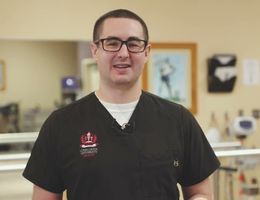
If joint pain, stiffness or limited mobility has stopped you in your tracks, we’ll help you take the next step. Our team of joint care experts helps you get relief so you can get back to doing the things you love.
Whether you need surgery or symptom relief, we offer treatments for every joint in the body. Our support staff, orthopaedic surgeons and physical therapists help you understand and consider the best options for you.
Why Choose Us for Joint Care
- Whole person care: We recognize how disruptive joint problems can be to your physical and mental health. Treating your joint pain is just the first step to help you live healthier and fuller in all areas of your life.
- Personalized approach: When you become our patient, you become family. We're committed to your follow-up care for as long as needed.
- Specialized care: Our orthopaedic surgeons specialize in specific joints to provide you the highest level of expertise. Your surgery is performed by some of the most experienced surgeons in the field of knee and hip replacement.
- Known for results: We’ll take care of you no matter how challenging your condition. Physicians throughout California know they can entrust their most complex cases to our team.
- Research and innovation: We’re working to improve joint implants and procedures all the time. Our team of researchers is dedicated to developing the next generation of joint replacements.
- Blue Distinction Center® for Knee and Hip Replacement: This national designation reflects expertise in total knee and total hip replacement surgeries, resulting in fewer patient complications and hospital readmissions.
Conditions We Treat
We provide treatment for conditions that weaken or cause pain in your joints. The most common is arthritis, which is inflammation or swelling in the joint. While arthritis can’t be cured, it can often be managed — and its symptoms may be significantly reduced by surgery.
- Osteoarthritis: damage to the protective cartilage around the bones in a joint. This is the most common form of arthritis.
- Joint pain, stiffness, swelling or loss of flexibility.
- Pain in the hip, knee, ankle or foot.
- Pain in the shoulder, elbow, wrist or hand.
- Pain walking, sitting down, standing up or bending over.
- Decreased mobility.
Services We Offer
Our approach to care starts with joint pain evaluation and management. We listen as you explain how joint pain is affecting your life. We may then perform tests (like X-rays) to better understand your condition. If your joint pain can be managed with treatments and therapies other than surgery, we’ll help you consider those options.
If you do need arthroplasty (surgery to restore joint function), you’re in good hands. Our team has decades of experience performing arthroplasty for every joint in the body. Arthroplasty includes:
- Joint replacement surgery (or replacement arthroplasty), to replace the surface of a joint with a prosthesis (artificial joint). The surgery may be total (the entire joint surface) or partial (just a damaged section). Joint replacement surgery can be a life-changing procedure capable of significantly reducing pain and restoring mobility. Over half of the procedures we perform are for joint replacement.
- Joint revision (or “repeat”) surgery, to replace your previous implant. Most patients enjoy their prosthesis for decades without the need for revision surgery. However, a revision may be necessary if your condition worsens, the joint becomes dislocated, the prosthesis loosens or the area becomes infected.
Joint replacement surgery and revision surgery is available for any joint, including:
- Hip, knee and ankle
- Shoulder, elbow and wrist
- Disks in the spine
- Finger and toe knuckles
Joint health tips: For Men’s Health Month, we shared tips both men and women can use to keep joints healthy.
When to See a Doctor
Many people tolerate their joint pain or limited mobility for years without consulting a doctor. But doing so may lead to worse, long-term damage. If you notice anything wrong with your joints, you should talk to a doctor as soon as possible. Depending on your condition, you may need to see:
- An orthopaedist, a surgeon specialized in bone and joint conditions. Our team includes some of the most experienced orthopaedic surgeons in the region.
- A rheumatologist, a doctor specialized in autoimmune diseases and non-surgical treatments. If needed, we’ll connect you with our colleagues in rheumatology.
If you don’t have an orthopaedist, talk to your primary care physician. They’ll be able to help diagnose your condition (usually with an X-ray) and refer you to an orthopaedist.
Do I need a referral?
Some insurances will require a referral. If you’re not sure what your insurance requires, call us and we’ll help you navigate the process.
If you’re not sure which specialist to see about your joint condition, that’s okay too. We’ll help you find the right care with our full team of expert specialists.
What to Expect
Getting Started
Living with joint problems can be difficult, and finding out you need surgery can be worrying. However, there’s never been a better time to get a joint replacement. With current surgical techniques, a modern artificial joint is simply a lasting, life-changing success.
If surgery isn’t right for you, there are a number of non-surgical options today to help manage your condition. We’ll help you understand the risks and benefits of each so you can make the best choice for your health.
Results and Outcomes
In the past, hip and knee implants only had about a 50% success rate. Today, about 90% of operations are successful for at least 10 years, with results lasting up to 40 years. On top of that, more than 95% of patients experience relief from joint pain.
Your First Visit
Whether you were referred to us or simply came in looking for relief from your joint pain, we’ll start by listening. You’ll meet with our team to talk about how your life has been affected by your joint condition. We may discuss topics like:
- Pain: How much does it hurt on a scale from 1-10? Are you limping? Is your shoulder pain waking you up in the night?
- Mobility: Do you have trouble walking through the grocery store? Have you fallen over because of your condition, with or without joint pain?
- Impact: Have you stopped doing activities you enjoy? When your family goes out, do you stay home? Have loved ones noticed something’s changed?
More than anything, we want you to be pain-free, move around easier and do what you love. If we can help you accomplish these without surgery, we’ll go over your treatment and management options. If your condition has become more serious, we’ll help you understand if surgery is right for you.
Diagnosis
We’ll start by discussing your daily activities, medical history and family history of diseases like arthritis. Diagnosing the specific condition causing your joint pain or limited mobility usually requires simple tests. Tests may include:
- Physical exam, to evaluate your joint’s mobility and how much pain movement causes.
- Imaging tests, to take images of your joint, including the cartilage and bone. These tests might include X-rays, ultrasound or MRI.
- Blood and fluid tests (and possibly referral to our rheumatologists), to determine what type of arthritis you have.
Treatment and Management
Depending on your diagnosis and the overall impact of your condition, your treatment and management options may be surgical or non-surgical.
Surgical
Joint replacement or revision (repeat) surgery is used to implant or replace an artificial joint (or prosthesis). These surgeries can significantly reduce pain and improve mobility. Today’s implants are durable enough to last more than 20 years without the need for revision surgery.
We’ll review the risks and benefits with you so you can decide when you’re ready for surgery.
Different surgical approaches may be used depending on the joint and the specific condition. Our team has expertise replacing every joint, including knees, hips, shoulders and elbows. Some of the advanced surgeries we perform include:
- Anterior hip approach, which uses a smaller incision at the front of the hip and avoids removing any muscle during hip replacement surgery. This approach can result in less pain after surgery, rapid recovery, increased mobility and much lower chance of hip dislocation.
- Mini posterior approach, which is more muscle sparing than the conventional approach and results in more rapid recovery. This approach can result in less pain and an earlier return to your activities.
- Reverse shoulder replacement, used when you have chronic rotator cuff muscle tearing and your shoulder has become arthritic. This surgery is a fairly new option, offering patients relief for a condition that could not be treated previously.
- Minimally invasive joint replacement, which uses fewer, smaller incisions and often results in a faster, less painful recovery.
After surgery, most patients can go home the same day or next day. For about the next two weeks, you’ll take pain medication for soreness caused by the surgery. After the second week, most patients start to see dramatic relief from soreness, pain and difficulty moving around. You’ll continue to heal and get used to your new joint over the next few months.
Non-Surgical
- Physical therapy, to strengthen muscles around the joint and improve your range of motion. Physical therapy may be used both after surgery and as an option for non-surgical management of your condition. With regular physical therapy, you may enjoy better results and a smoother, faster recovery. Our expert physical therapists are ready to support you through your healing journey. If you live far away, we can help you choose a physical therapist closer to home.
- Lifestyle changes, including assistive devices for walking (like canes or walkers) and exercise (to lose weight and improve joint function).
- Anti-inflammatory medications, which help reduce inflammation or swelling to improve symptoms
- Injection therapies, which might include nerve blocks (to stop pain from certain nerves) or corticosteroids (to reduce inflammation and immune system response). Your joint may also need a lubrication injection to ease joint movement.
- Pain medications, which can help reduce debilitating pain. If your condition has become serious, a more powerful pain medication may be required for a limited time period. Once other treatments are helping reduce your pain, we’ll help you slow and stop the use of any pain medications.
Follow-Up
As long as you’re comfortable with managing your condition through non-surgical options, we’ll continue to see you as needed. Whenever you’re ready, we can discuss your surgical options and consider the risks and benefits. Our whole team is here to answer any questions you have, from day one through every follow-up appointment.
After joint replacement surgery, follow-up appointments are an important part of the healing journey. Our friendly and knowledgeable staff will help you schedule your follow-ups.
Most patients need a few follow-ups in the weeks and months after surgery to evaluate how a joint is recovering. At the one-year mark, you’ll likely be fully recovered and we’ll schedule a follow-up to evaluate your progress.
Beyond one year, we’ll discuss the best follow-up schedule for your condition and implant. You may need to come in annually, every other year or every five years. After 10 years, we like to see our patients every one or two years to check up on normal wear and tear.
Take the Next Step
If moving your joints has become difficult or painful, don’t let your condition continue to worsen. Talk to your primary care physician or make an appointment with our orthopaedic specialists.
Preparing for Surgery and Recovery

Before Your Surgery

After Your Surgery











